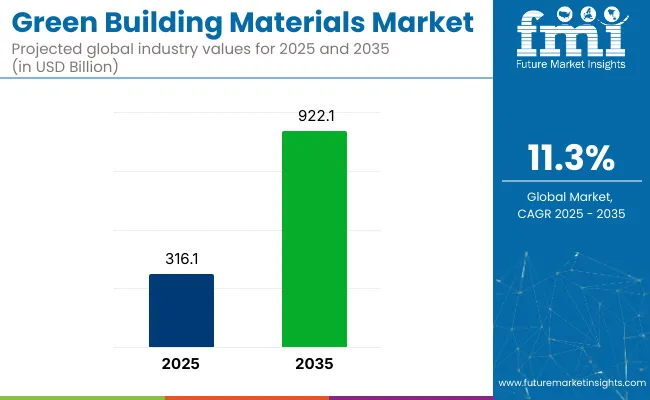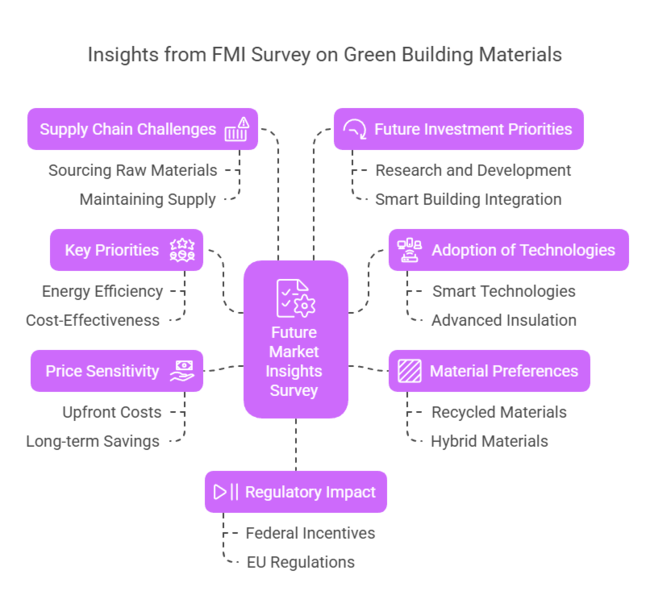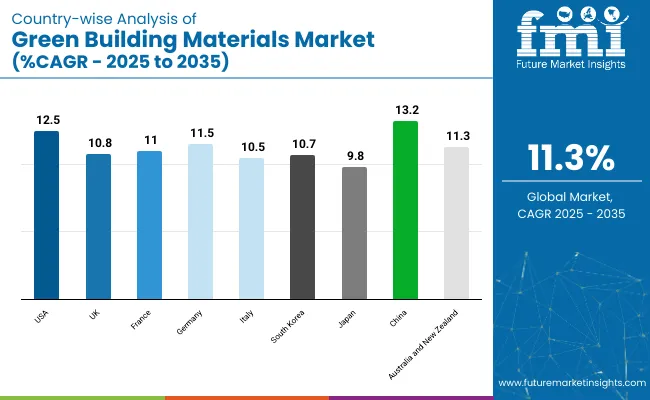The green building materials market is projected to grow from USD 316.1 billion in 2025 to USD 922.1 billion by 2035, reflecting a compound annual growth rate (CAGR) of 11.3%. Growth is being supported by regulatory actions across the USA and Europe, in conjunction with increasing demand for sustainable construction materials, bio-based polymers, and energy-efficient components across industries.
In the United States, legislative support has intensified following the introduction of bipartisan initiatives aimed at improving green building standards. According to a 2024 report by Canary Media, new legislation has mandated the use of low-carbon construction materials in federally funded building projects.
This regulatory framework has boosted demand for verified green products in public infrastructure development. Additionally, the USA Environmental Protection Agency (EPA) continues to promote sustainable construction practices through programs such as ENERGY STAR and Smart Growth initiatives, which encourage the use of environmentally preferable building materials.
In Europe, regulatory changes have further advanced the market. A new EU regulation, adopted in January 2025, has introduced harmonized rules for the safety and sustainability of construction products across member states. The European Commission has emphasized that these measures aim to enhance product transparency and lifecycle efficiency while preserving industry competitiveness. These frameworks require manufacturers to disclose environmental performance metrics, thereby strengthening the adoption of certified green materials.

| Metrics | Values |
|---|---|
| Industry Size (2025E) | USD 316.1 billion |
| Industry Size (2035F) | USD 922.1 billion |
| CAGR | 11.3% |
Certifications and third-party environmental assessments are also supporting growth. Organizations such as Tunley Environmental have reported an uptick in demand for Life Cycle Assessments (LCAs), Environmental Product Declarations (EPDs), and carbon accounting services to support green material claims. Projects that comply with LEED, BREEAM, or WELL building certifications are increasingly mandating these third-party verifications for qualifying materials used in construction and retrofit projects.
Product innovations have included expanded use of recycled concrete aggregates, cross-laminated timber (CLT), cellulose insulation, and biodegradable polymers. Corporate initiatives have accelerated in alignment with decarbonization goals. Key materials suppliers have increased investment in recycled feedstocks, carbon capture-integrated cement, and plant-based construction polymers.
In the future, procurement frameworks are expected to favor regional and circular supply chains. With regulatory compliance and environmental impact disclosures becoming mainstream, the green materials market is positioned to witness sustained demand growth through 2035. Strategic emphasis will likely remain on low-embodied carbon materials, digital traceability platforms, and harmonized international sustainability standards.
Structural materials are estimated to account for approximately 39% of the global green building materials market share in 2025 and are projected to grow at a CAGR of 11.5% through 2035. Demand is driven by their fundamental role in framing, foundation, and load-bearing applications across residential and commercial construction.
Builders and developers are increasingly adopting fly ash-based cement, cross-laminated timber (CLT), and high-recycled-content steel to reduce embodied carbon and improve lifecycle energy efficiency. Innovations in geopolymer concrete, carbon-negative aggregates, and sustainable prefabricated components are gaining momentum in both developed and emerging markets.
Governments and green certification programs such as LEED, BREEAM, and IGBC continue to incentivize the use of structural materials that align with circular economy goals and net-zero emissions targets.
Commercial buildings are projected to account for nearly 34% of the global green building materials market share in 2025 and are expected to grow at a CAGR of 11.6% through 2035. This segment benefits from large-scale urbanization, ESG-led investment strategies, and rising demand for energy-efficient office spaces, hotels, and retail complexes.
In Europe and North America, green building codes and tax incentives are driving the adoption of thermally efficient insulation, low-emission interior products, and smart facade systems. Real estate developers and facility owners prioritize materials that support indoor air quality, moisture control, and reduced HVAC load, thereby boosting demand across both new construction and retrofit projects.
As commercial tenants seek wellness-certified and environmentally compliant spaces, green building materials form a core component of value-added construction across global commercial portfolios.
The industry for green building products is poised for robust growth, driven by more stringent environmental laws, increased demand for energy-efficient buildings, and innovations in environmentally friendly construction techniques.
Businesses manufacturing green insulation, cross-laminated wood, and reused products will reap the benefits. However, conventional material suppliers will lose if they do not diversify.
The change will be supported by governments, green builders, and ecologically aware buyers, who will drive demand for green materials to industry standards from current exceptions.
Invest in Sustainable Innovation
Prioritize R&D in eco-friendly materials, such as bio-based composites, recycled content, and carbon-neutral concrete, to stay competitive. Partner with research institutions and startups to accelerate breakthroughs and differentiate product offerings.
Align with Regulatory and Market Trends
Adapt to evolving sustainability mandates by ensuring compliance with green building certifications (LEED, BREEAM) and government incentives. Develop products that align with net-zero carbon goals to capitalize on the growing demand from developers and corporate ESG initiatives.
Expand Strategic Partnerships and Supply Chain Resilience
Strengthen collaborations with sustainable construction firms, architects, and policymakers to drive industry adoption. Invest in localized production and raw material sourcing to mitigate supply chain disruptions and reduce carbon footprints.
| Risk | Probability & Impact |
|---|---|
| Regulatory Uncertainty: Shifting government policies or inconsistent green building standards may create compliance challenges. | Medium Probability, High Impact |
| High Material Costs: The price volatility of sustainable raw materials could limit affordability and adoption. | High Probability, Medium Impact |
| Slow Market Adoption: Resistance from traditional builders and developers may delay widespread implementation. | Medium Probability, High Impact |
1-Year Executive Watchlist
| Priority | Immediate Action |
|---|---|
| Sustainable Material Sourcing: Ensure a stable supply of eco-friendly raw materials. | Run a feasibility study on regional sourcing for recycled and bio-based materials. |
| Regulatory Compliance & Certifications: Stay ahead of evolving green building mandates. | Initiate legal and market review to align with upcoming LEED and BREEAM updates. |
| Market Adoption Acceleration: Drive demand for green materials among developers. | Launch a targeted incentive program for builders adopting sustainable products. |
To maintain competitiveness, companies must step up their investment in green innovation, enhance regulatory harmonization, and deepen strategic alliances. As green building regulations become stricter and there is a growing demand for environmentally friendly products, the time to scale carbon-neutral and recycled material R&D and secure low-cost supply chains is now. Prioritizing adaptation to changing LEED and BREEAM standards will open new revenue streams, and a push into incentives for builders and developers can accelerate industry take-up.
In Q4 2024, Future Market Insights (FMI) conducted a comprehensive survey involving 450 stakeholders from the green building materials sector, including manufacturers, distributors, architects, and developers across the United States, Western Europe, Japan, and South Korea. The survey revealed the following key insights:
Regional Variations
Recycled and Renewable Materials: Globally, 68% of stakeholders preferred materials made from recycled or rapidly renewable resources.
Regional Variations
Global Challenge: 80% of respondents cited the higher upfront costs of green building materials as a significant barrier to the adoption of green building practices.
Regional Insights
Research and Development: 70% of global manufacturers plan to invest in R&D to innovate and improve the performance and affordability of green building materials.
Regional Focus

| Countries | Policies and Regulations |
|---|---|
| United States |
|
| United Kingdom |
|
| India |
|
| Japan |
|
| Singapore |
|
| Malaysia |
|
| Qatar |
|

The American green building materials industry is driven by strict environmental policies, growing consumer awareness, and a high-performing building industry.
The American industry is expected to hold a major share in the global industry. The Leadership in Energy and Environmental Design (LEED) certification continues to support green construction practices, further fuelling industry growth.
FMI opines that the United States' green building materials sales will grow at a nearly 12.5% CAGR through 2035.
The market for green building materials in the UK is forecasted to increase at a CAGR of about 10.8% from 2025 to 2035.
The industry growth in the UK is an indication of the country's interest in sustainable development. The Building Research Establishment Environmental Assessment Method (BREEAM) certification has played a crucial role in promoting the use of environmentally friendly materials.
FMI opines that the United Kingdom's green building materials sales will grow at nearly 10.8% CAGR through 2025 to 2035.
France's green building materials industry is expected to expand rapidly from 2025 to 2035. The French government's focus on minimizing carbon emissions and sustainable urban growth propels the industry.
Policies like the HQE (Haute Qualité Environnementale) certification support the utilization of eco-friendly materials in buildings.
FMI opines that the French green building materials market sales will grow at nearly 11.0% CAGR through 2025 to 2035.
Germany is expected to experience significant growth in the green building materials industry over the projection period.
The engineering prowess of the country and policy push towards the Energiewende program to move towards a sustainable energy system support the sales of green building materials.
The DGNB (Deutsche Gesellschaft für Nachhaltiges Bauen) certification also encourages sustainable building activities.
FMI opines that Germany's green building materials sales will grow at nearly 11.5% CAGR through 2025 to 2035.
Italy's industry for green building materials will increase at a CAGR of approximately 10.5% between 2025 and 2035. The country's high level of architectural heritage, along with its growing emphasis on sustainable tourism and resulting efforts to renovate ancient structures using environmentally friendly products, enhances the industry.
Embracing procedures such as ITACA promotes the integration of sustainability in the building sector.
FMI opines that Italy's sales of green building materials will grow at a nearly 10.5% CAGR from 2025 to 2035.
South Korea is estimated to witness a CAGR of about 10.7% from 2025 to 2035 in its green building materials industry. The industry is driven by government policies that favor energy-efficient buildings and smart city initiatives.
The G-SEED (Green Standard for Energy and Environmental Design) certification encourages the adoption of sustainable materials throughout the construction industry.
FMI opines that South Korea's green building materials sales will grow at nearly 10.7% CAGR through 2025 to 2035.
The industry size for green building materials in Japan is expected to expand rapidly from 2025 to 2035. The industry is driven by the implementation of green building materials to reduce natural disaster risks and enhance public health.
The Comprehensive Assessment System for Built Environment Efficiency (CASBEE) certification encourages the incorporation of environmentally friendly building materials into construction activities.
FMI opines that Japan's green building materials sales will grow at nearly a 9.8% CAGR through 2025 to 2035.
China is anticipated to register a strong growth in the green building materials industry from 2025 to 2035.
The industry is driven by escalating urbanization and government policies that support sustainable construction. Initiatives such as the Green Building Evaluation Standard facilitate the use of green materials.
FMI opines that China sales will grow at a nearly 13.2% CAGR from 2025 to 2035.
The Australian and New Zealand green building materials market is estimated to expand at a CAGR of approximately 11.3% from 2025 to 2035.
Both nations have demonstrated a considerable commitment to sustainability, with initiatives such as Green Star in Australia and Homestar in New Zealand encouraging the incorporation of environmentally friendly materials in construction.
Government policies and increasing awareness among consumers of environmental concerns are further fuelling the growth of the industry.
These nation-specific insights highlight the distinct growth trajectories of the industry at the global level, which are shaped by domestic policies, certifications, and industry-specific conditions.
FMI opines that Australia-NZ green building materials sales will grow at nearly 11.3% CAGR through 2025 to 2035.
The industry for green building materials is led by a few major companies trying to expand their reach. They are growing their businesses by acquiring other companies and forming partnerships, all with the goal of providing more environmentally friendly products.
These companies focus on making new and better products, keeping costs competitive, and expanding by merging with or buying out other businesses.
For example, in February 2024, Holcim, a notable company, acquired ZinCo, renowned for its green roofing systems. This acquisition aimed to strengthen Holcim's business in the sustainable roofing sector.
Stricter regulations, sustainability goals, and cost savings fuel adoption.
They enhance insulation, reduce heat absorption, and lower energy use.
Residential, commercial, and institutional buildings lead adoption.
Self-healing concrete, bio-based insulation, and solar-integrated roofing.
Yes, tax credits, grants, and subsidies promote eco-friendly construction.






Full Research Suite comprises of:
Market outlook & trends analysis
Interviews & case studies
Strategic recommendations
Vendor profiles & capabilities analysis
5-year forecasts
8 regions and 60+ country-level data splits
Market segment data splits
12 months of continuous data updates
DELIVERED AS:
PDF EXCEL ONLINE
Green and Bio-based Polyol Market Size and Share Forecast Outlook 2025 to 2035
Green Ammonia Market Size and Share Forecast Outlook 2025 to 2035
Green Cement Market Size and Share Forecast Outlook 2025 to 2035
Green Power Market Size and Share Forecast Outlook 2025 to 2035
Green Chemicals Market Size and Share Forecast Outlook 2025 to 2035
Green Power Transformer Market Size and Share Forecast Outlook 2025 to 2035
Green Preservatives Market Size and Share Forecast Outlook 2025 to 2035
Green Tea Supplements Market Analysis - Size, Share, and Forecast 2025 to 2035
Green Data Center Market Size and Share Forecast Outlook 2025 to 2035
Green Logistics Market Size and Share Forecast Outlook 2025 to 2035
Green Methanol Market Size and Share Forecast Outlook 2025 to 2035
Green Technology And Sustainability Market Size and Share Forecast Outlook 2025 to 2035
Greenwrap Market Analysis - Size, Share, and Forecast Outlook 2025 to 2035
Green Coatings Market Analysis by Technology, Application, and Region Forecast through 2035
Green UPS Market - Trends & Forecast 2025 to 2035
Green Tire Market Growth – Trends & Forecast 2025 to 2035
Green Tea Extracts Market Analysis – Size, Share & Forecast 2025 to 2035
Green Banana Flour Market Analysis - Growth & Demand 2025 to 2035
Green Transformer Market Growth – Trends & Forecast 2025 to 2035
Green Electronics Manufacturing Market – Sustainability & Trends 2025 to 2035

Thank you!
You will receive an email from our Business Development Manager. Please be sure to check your SPAM/JUNK folder too.
Chat With
MaRIA